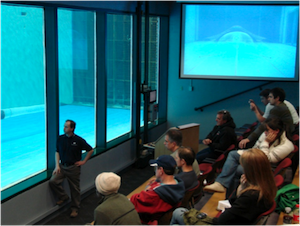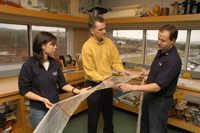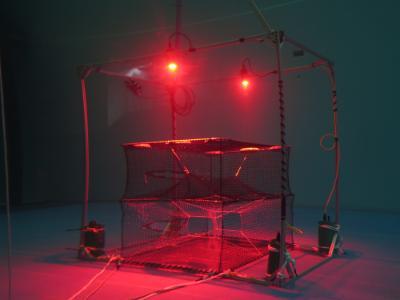Facilities
Constructed at a cost of $8.5 million CAD and first opened in 1988, the Marine Institute flume tank provides the physical environment required to 
- carry out performance evaluations, gear tests and other observations on newly developed or existing fishing gears and other related equipment in simulated underwater and near surface conditions
- provide technical services for fishermen, fishing equipment manufacturers/suppliers, other fishing industry groups and public and private organizations
- demonstrate the operations and behaviour of fixed and mobile fishing gear in water to members of the fishing industry and the general public
Dimensions:
The test section is 8m wide x 4m deep x 22.25m long (the water level may be changed from 4m to 3m depth). These dimensions make the tank the largest flume tank of its type in the world.
Viewing Gallery:
The viewing gallery is able to accommodate approximately 150 people and faces a 20m x 3m observation window looking into the side of the flume tank's test section.
Capacity:
The flume tank contains 1.7 million litres of water when full.
Engineering Performance:
Tank is divided horizontally into 2 sections. The lower section allows water to circulate. The upper test section holds the gear and allows observation from above and from one side.
Tank Sides:
The sides are made of reinforced concrete, except for the viewing side, which is acrylic.
Circulation:
Three pumps or impellers located in the return section circulate the water around the tank. Each impeller or pump is driven by a 125 HP DC motor. During circulation water passes through a flow straightening device in the lower section which takes out the swirl.
The water flows along to the first set of turning vanes, up into the test section and passes through an additional screen which produces a more uniform water flow.
Water Velocity:
- 0 - 1 metre per second
- Typically equivalent to: 6 knots at 1:10 scale, i.e. 3 m/s
- 2 knots at full scale, i.e. 1 m/s
Uniform Water Velocity:
Produced by screens, vanes, a deflector and a wave damper.
Moving Ground Plane:
Can move at same speed as water, at a selected speed, or remain stationary.
Functions include:
- Simulating seabed for bottom trawls
- Eliminating eddies caused by fluid friction against a stationary surface
Flume Tank Control:
Water speed, belt speed and towing mast position are controlled through the use of a control computer and two Programmable Logic Controllers (PLC). One PLC is used to control the operation of the towing mast. Another is used to control water speed and belt speed.
Data Acquisition and Flow Monitoring:
A 32-channel, high-speed, data-acquisition system is used to collect drag forces from the object under test. A number of load cells are available for underwater use with ranges from 2 kg to 45 kg.
CSAR has a number of underwater cameras available for at-sea field work. Depending on the application, video signals may be viewed real-time via umbilical, or stored in self-contained recording bottles.
Both standard definition and high definition (HD) cameras are available, with customizable options for variable resolution and frame rate. The Centre also has a small work class remotely operated vehicle (ROV) for gear observations in shallow water from land or from the working deck of a small fishing vessel.
Specification for the ROV can be found at the Outland Technology website.
Specificiation for the underwater cameras can be found at the SubC Control website.
The development of fishing gears for the commercial fishing industry has changed dramatically over the last few decades. Today's modern designs are more advanced and sophisticated as a result of increasing fuel costs, the need for species- and size-selectivity, stringent bycatch restrictions, and the necessity to minimize impact on the environment.
Meeting these challenges has lead to significant improvements in the way new fishing gears are designed and tested. This includes advances in computer design, numerical simulation, physical modeling, flume tank capability, and direct observation using underwater cameras, acoustics, and trawl-mounted sensors.
The Centre offers numerical simulation capability using DynamiT software developed by IFREMER. The software has the ability to evaluate the hydrodynamic performance of virtually any trawl type.
It is used by the research team to visualize the effect of certain materials and design features on trawl shape and performance under different rigging and towing scenarios.
The software is used to test the viability of design concepts prior to physical modelling and full-scale prototype evaluations. Performance testing of scale engineering models is conducted using the flume tank.
Calculations are carried out using Froude scaling rules to ensure the results from the flume tank testing have validity for the full-scale fishing gear.
Choosing the appropriate scale (e.g., 1:3) requires finding a balance between the limitations of the test facility (i.e., flume tank size), objectives of the test program, ability to extrapolate model results to full-scale performance, and the ability to source components for the model. In almost all cases, the majority of components have to be custom ordered or fabricated in-house.
CSAR houses the Marine Institute's hydrostatic test chamber. The 70 liter chamber is able to simulate ocean depths of up to 1800m.
Floats tested The chamber has been used by various clients over the past several years for various purposes including:
- testing the integrity of O-ring seals for fisheries/marine related
- instrument housings
- verifying the depth capability of fishing floats
- demonstrating the affects of pressure on both rigid and non-rigid
- floats during fisheries workshops
- destructive testing of instrument housings fitted with GPS for use in the tracking of marine mammals
The chamber has been recently upgraded to allow for logging of pressure data while tests occur.
Future upgrades will allow the buoyancy of an object to be logged simultaneously with depth data and should be particularly useful in determining the effects of buoyancy on non-rigid floats.


